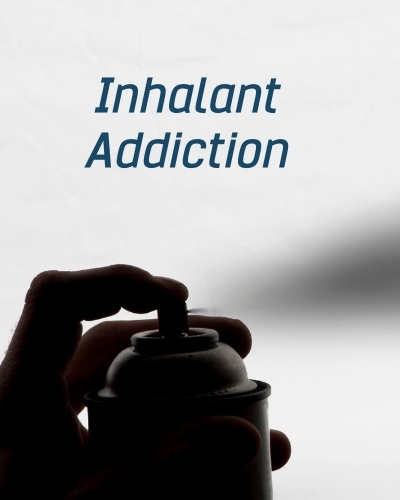What Are Inhalants?
Inhalants are volatile substances that produce chemical vapors that can be inhaled to induce a psychoactive or mind-altering effect. Solvents (such as paint thinners, gasoline, glues, organic solvents, nail polish remover), gases (such as butane, propane, aerosol propellants), nitrous oxide, hair spray, and nitrites (such as isoamyl, isobutyl, and cyclohexyl) are some of the most commonly abused inhalants.
A 2007 animal study indicates that toluene, a solvent found in many commonly abused inhalants such as model airplane glue, paint sprays, and paint and nail polish removers, activates the brain’s dopamine system. The dopamine system plays a vital role in the rewarding effects of nearly all drugs of abuse. This is according to the National Institute on Drug Abuse (NIDA) [1]

Generally, inhalants can be physically and psychologically addictive. Users report a strong urge to continue using inhalants, especially after continued usage over many days. Consequently, habitual users coming off inhalants suffer withdrawal symptoms which can include nausea, excessive sweating, muscle cramps, headaches, chills, agitation, shaking, and hallucinations. Unfortunately, in severe cases, withdrawal can cause life-threatening convulsions.
Signs of Inhalant Abuse
According to the National Center for Biotechnology Information (NCBI) [2], 25.8 million persons (9.6%) aged 12 or older have used inhalants in their lifetime. That is why early detection and intervention are the best ways to stop inhalant abuse before it causes serious health problems. Given that, parents, educators, family doctors, and other health care practitioners should be alert to the following addiction signs:
- Chemical odors on breath or clothing
- Paint or other stains on face, hands, or clothes
- Hidden empty spray paint or solvent containers, and chemical-soaked rags or clothing
- Drunk or disoriented appearance
- Slurred speech
- Nausea or loss of appetite
- Inattentiveness, lack of coordination, irritability, and depression

Classes Of Inhalants
Solvents
- Paint thinners
- Dry cleaning fluids
- Gasoline
- Lighter fluid
- Correction fluids
- Felt-tip marker fluid
- Electronic contact cleaners
- Glue
- Nail polish
- Nail polish remover
Aerosols
- Spray paint
- Hair spray
- Deodorant spray
- Aerosol computer cleaning products
- Vegetable oil sprays
Nitrites
- Video head cleaner
- Room odorizer
- Leather cleaner
- Liquid aroma
Gases
- Butane lighters
- Propane tanks
- Whipped cream dispensers (commonly referred to as Whippets)
- Ether
- Chloroform
- Nitrous Oxide (“Laughing Gas”)
- Freon
Dangers of Using Inhalants
Inhalant use is dangerous in many ways. Generally, most inhalants are highly flammable as well. Provided that, recklessness with lit cigarettes and flames while using inhalants has caused tragic accidents. The following are the most common danger of using inhalants.
Suffocation
- Solvents are often sniffed from a plastic bag, which is held firmly around the nose and mouth. People who use solvents sometimes pass out with the bag still in place and suffocate because of running out of oxygen. It could also cause fatal choking on vomit when unconscious.
Recklessness
- Sniffing reduces inhibition and affects the way people feel about themselves and the world around them. It makes some people feel powerful, which has led to dangerous and destructive behavior that caused severe harm. Others don’t get high when they sniff; but they get depressed. Moreover, self-destructive or suicidal behavior is typical among people who use solvents.
Sudden Sniffing Death (SSD)
- Prolonged sniffing of highly concentrated inhalants can cause a rapid and irregular heartbeat, leading to death from heart failure. SSD can occur after only one sniffing session and when stress or strenuous exercise follows several deep inhalations.
Serious Health Problems
- People who use solvents regularly for a long time can damage their liver, kidneys, lungs, heart, brain, bones, and blood. Sometimes this damage heals when drug use is stopped, but a lot of times the impairment is permanent.
Fetal Solvent Syndrome
- Use of solvents during pregnancy, especially chronic use, can result in premature birth, congenital disabilities, or stillbirth.
Effects of Inhalants
Taking inhalants is considered misuse because of the severe damage these substances can inflict on the body. To emphasize, most inhalants affect the central nervous system (CNS) and slow down brain activity. Also, higher doses or deep breathing of these solvents can result in a fatal overdose.
Short-Term Effects Are Similar to Alcohol and Include:
- Slurred or Distorted Speech
- Hallucinations
- Blacking Out
- Lack of Coordination (control of body movement)
- Dizziness
Additional Long-Term Effects of Inhalant Use Include:
- Liver and Kidney Damage
- Hearing Loss
- Bone Marrow Damage
- Loss of Coordination and Limb Spasms
- Nerve Damage
- Delayed Behavioral Development
- Brain Damage
Inhalant Overdose
An inhalant overdose happens when a person uses too much of a drug and has a toxic reaction that results in severe, harmful symptoms or death. Moreover, inhalants act as Central Nervous System (CNS) depressants, and higher doses or deep breathing of these solvents can result in a fatal overdose. A fatal overdose is generally the result of heart failure, asphyxiation, or the drug causing the user to stop breathing on their own.
Many solvents and aerosol sprays are highly concentrated, in other words, they contain a large number of chemicals with a lot of active ingredients. In addition, sniffing these products can cause the heart to stop within minutes. This condition, known as sudden sniffing death, can happen to otherwise healthy young people the first time they use an inhalant.
Inhalant Addiction
Repeated use of inhalants can lead to addiction, a form of substance use disorder (SUD). It develops when continued drug use causes issues, such as health problems and failure to meet responsibilities at work, school, or home. Substance Use Disorder can range from mild to severe, the most severe form being addiction. Furthermore, intoxication from taking inhalants lasts up to 30 minutes for most inhalants; that is why people who abuse these substances usually inhale several times over several hours to prolong this high.

Withdrawal from Inhalants
Those who try to quit inhalants may have withdrawal symptoms. These symptoms may include the following:
- Rapid Pulse
- Panic, Anxiety, and Mood Swings
- Sweating
- Shaking or Tremors
- Nausea or Vomiting
- Physical and Emotional Agitation
- Hallucinations
- Grand mal Seizures (falling down, convulsions, loss of consciousness, loss of bowel and bladder control)
Inhalants Addiction Treatment
Underestimating the severity of Inhalants abuse can be dangerous. Misuse of the drugs can cause brain damage, liver and kidney damage, hearing loss, and death. These harmful effects can occur immediately after or while using the substance. Therefore, most individuals who suffer from Inhalant addiction need professional treatment.
Addiction treatment in an inpatient rehab center allows individuals struggling with inhalant abuse to overcome substance abuse in a safe environment, removed from any harmful triggers. In addition, a drug rehab center may provide professional care, evidence-based treatment methods, and peer support which makes all the difference in recovery success.
Because many addictions coincide with another disorder, it is vital that you find a rehab that specializes in treating co-occurring conditions. This requires that the treatment program understands the importance of taking the time to discover if there is another disorder at hand that may be playing into a substance use disorder before treating only the substance abuse. With a thorough investigation of an individual’s mental health condition before treatment, the individual will surely receive the most effective and comprehensive treatment for their addiction and mental health disorder. Consequently, this only strengthens their chances of maintaining their sobriety upon leaving the rehab facility.
Find the Right Primary Mental Health Treatment Plan with Co-Occurring Secondary Addiction Diagnosis
During your rehabilitation, the staff from your treatment facility will help you identify the cause of addiction and teach skills that will help change the client’s behavior patterns and challenge the negative thoughts that led to addiction. Sometimes, the pressures and problems in life lead the person to rely on substances to help them forget about their issues momentarily. That is why we offer holistic treatment to approach any possible underlying issues.
To clarify, recovering from a substance use disorder does not need to be overwhelming or burdensome. With supervision from an inpatient drug rehab, you will be on the way to lifelong sobriety in no time. That is why don’t hold advancing in your sobriety.
So, if you or someone you love is struggling with inhalants misuse, get them the safest help they need because everyone deserves a chance to heal.
Inpatient medical detox and residential primary addiction treatment may be available at our affiliated facility at Level Up West Palm Beach Rehab. For some primary behavioral health treatment clients, medical detox and or addiction rehab may be required first. If you have a co-occurring severe substance abuse diagnosis, please contact us prior to beginning inpatient mental health therapy. Treatment services may vary. Please call us to learn which treatment options are most suited for your individual needs.
Sources
[1] NIDA – https://www.drugabuse.gov/publications/research-reports/inhalants/how-do-inhalants-produce-their-effects
[2] NCBI – https://www.ncbi.nlm.nih.gov/books/NBK424847/table/appd.t5/
[3] Inhalant Abuse Treatment » Drug Alcohol Addiction – We Level Up